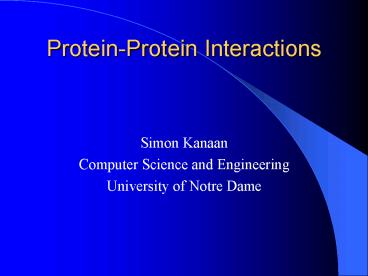Protein-Protein Interactions - PowerPoint PPT Presentation
1 / 7
Title:
Protein-Protein Interactions
Description:
Protein-Protein Interactions. Simon Kanaan. Computer Science and Engineering ... Scientists can not test all the combinations of Proteins since there are too ... – PowerPoint PPT presentation
Number of Views:133
Avg rating:3.0/5.0
Title: Protein-Protein Interactions
1
Protein-Protein Interactions
Simon Kanaan Computer Science and
Engineering University of Notre Dame
2
Why Bother Studying Protein-Protein (p-p)
Interactions?
- Protein-Protein interactions occur in any living
organism. - Scientists can not test all the combinations of
Proteins since there are too many proteins, and
they are not easy to isolate - Knowledge of p-p interactions allows us to
understand the internal structures of a living
organism.
3
Background
- Biological Research has given us some knowledge
of the structure of proteins. - Proteins contain a sequence of information called
a domain, where each protein contains a certain
number of domains. - There are large databases containing p-p
interactions and their domains, which are derived
from enormous amounts of lab experimentation
4
How Do We Plan on Predicting p-p interactions?
- We are able to predict which proteins interact
with which by looking at the domain level. - We have written a number of algorithms all of
which look at the p-p pairs known and attempt to
figure out which pair of domains explains each of
the interactions.
5
Implemented Algorithms
- ChengBang's algorithm
- -constructs a vector of most common interacting
domain-domain (D-D) pair to least common needed
to explain all P-P interactions given in input
file. - Simon's algorithm
- -constructs a vector starting from most common
interacting D-D pair of the most common domain
needed to explain all P-P interactions given in
input file.
6
Algorithms in Progress
Chengbang's and Simon's algorithms with the
following modifications -taking into
consideration absence of edges by subtracting by
one in our D-D matrix for every missing
edge. -instead of only taking into account the
most common D-D interaction of the most frequent
domain, take all D-D interactions from most to
least common of most frequent Domain.
7
Direction We Are Heading
- Our first step is to finish implementing all the
algorithms explained in this presentation - Second, there are a a couple more complicated
algorithms being looked at/developed which will
also need to be implemented. - We also need to test our algorithms to see how
robust and accurate they are.































